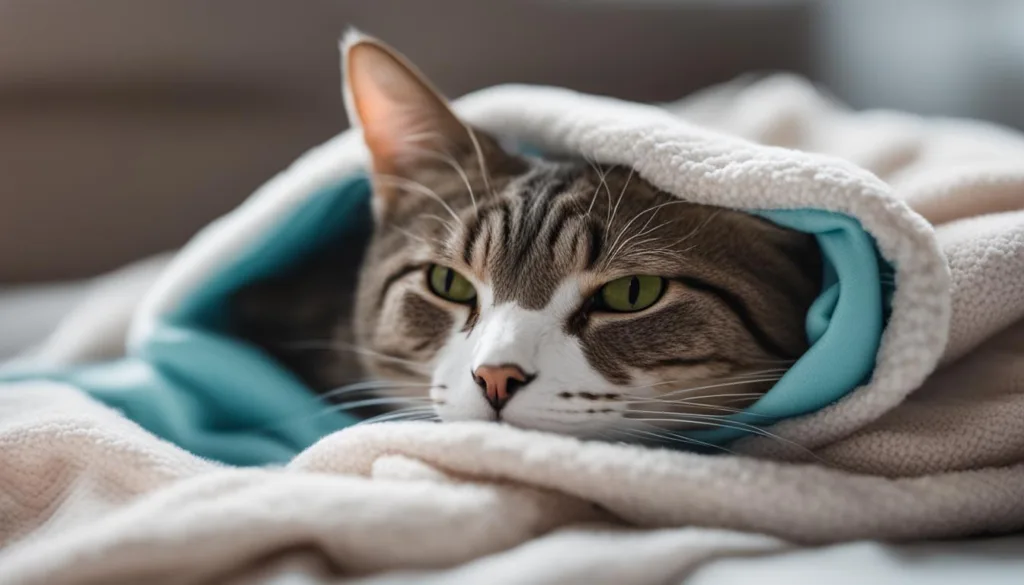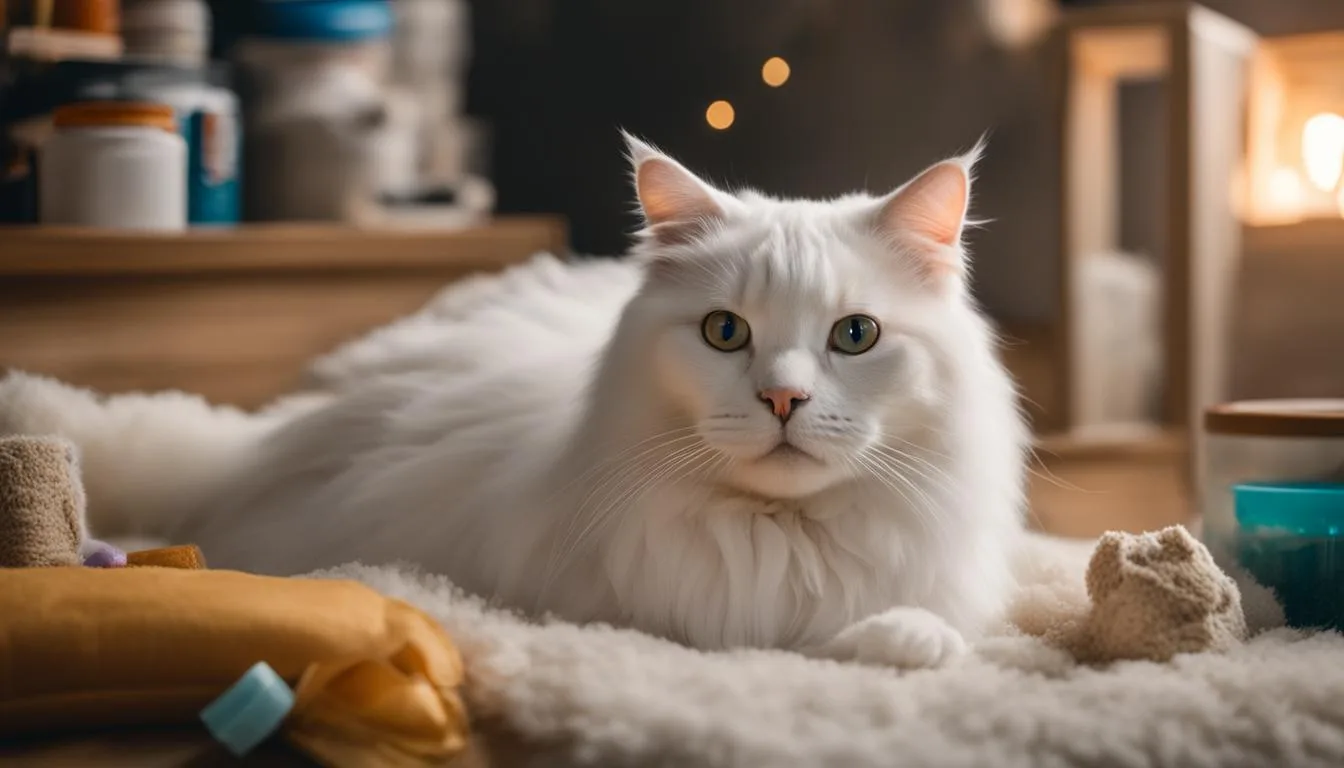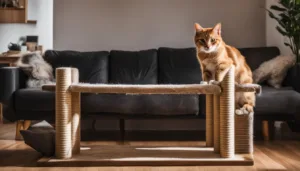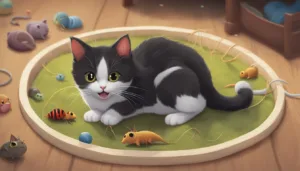Declawing a cat is a controversial procedure that involves the removal of part of the cat’s toes. It can cause physical and mental pain for the cat. In this guide, we will provide tips and guidance on how to care for a cat after declaw surgery, as well as alternatives to declawing that can protect your furniture without causing harm to your cat.
- The Harsh Reality of Declawing
- Understanding Post-Surgery Care
- Managing Pain and Discomfort
- Preventing Complications
- Promoting Healing and Recovery
- Behavior Changes After Declawing
- Providing Alternative Scratching Options
- Ensuring Long-Term Comfort and Wellness
- The Importance of Education and Awareness
- The Role of Veterinarians in Cat Care After Declaw
- Conclusion
- FAQ
- Source Links
Key Takeaways:
- Cat care after declaw is essential for the well-being of your feline companion.
- Consider alternatives to declawing, such as nail caps or regular nail trimming, to protect your furniture.
- Provide a comfortable environment for your cat during the recovery period.
- Work with your veterinarian to develop a pain management plan for your cat.
- Monitor for signs of infection or complications and seek veterinary care if needed.
The Harsh Reality of Declawing
Declawing is a controversial procedure that involves the amputation of part of a cat’s toes. While some may view it as a simple solution to prevent furniture damage, the reality is much harsher. Declawing can cause significant physical and mental pain for cats, with long-lasting consequences. It’s essential for cat owners to understand the true nature of declawing and explore alternative options that prioritize the cat’s well-being.
The physical consequences of declawing are severe. When a cat undergoes this procedure, the amputation of their toes can result in chronic pain and long-term physical limitations. The act of scratching serves various purposes for cats, including stretching their bodies, maintaining their claws, and marking territory. By removing their ability to scratch, declawing significantly impacts their natural behaviors and can lead to both physical and emotional distress.
In addition to physical pain, declawing can also have mental and behavioral repercussions. Cats rely on their claws for balance, self-defense, and communication. Without this vital tool, they may become more anxious, exhibit aggression, or develop litter box aversion. It’s crucial to recognize that declawing is not a quick fix, but rather a surgical procedure that can significantly impact a cat’s overall well-being.
As cat owners, it is our responsibility to seek out alternatives to declawing that are more humane and effective. Providing appropriate scratching surfaces, such as scratching posts or cardboard scratchers, can help redirect a cat’s scratching behavior. Regular nail trims and using soft nail caps are also viable options to prevent damage to furniture without causing harm to the cat. By exploring these alternatives, we can protect our furniture while prioritizing the physical and mental health of our feline companions.
| Consequences of Declawing | Physical Pain from Declawing | Alternatives to Declawing |
|---|---|---|
| Chronic pain | Amputation of toes | Providing scratching surfaces |
| Physical limitations | Long-term physical distress | Regular nail trims |
| Mental and behavioral repercussions | Loss of scratching behavior | Soft nail caps |
Understanding Post-Surgery Care
After declaw surgery, cats require special post-operative care to ensure proper healing and minimize discomfort. It is essential to create a conducive environment that promotes their recovery. Additionally, monitoring for any signs of infection or complications is crucial to prevent further issues.
One key aspect of post-surgery care is managing pain. Cats may experience discomfort after the declaw procedure, and appropriate pain management medications should be administered as prescribed by the veterinarian. Providing a comfortable and quiet space for the cat to rest is also essential during the recovery period.
Long-term care for declawed cats goes beyond the immediate post-surgery phase. It is important to pay attention to any behavioral changes that may occur, such as changes in litter box habits or increased aggression. Providing alternative scratching surfaces, like scratching posts or cardboard scratchers, can help redirect their scratching behavior and prevent furniture damage.
| Post-surgery care for declawed cats | Recovery process after declaw surgery | Managing pain after declawing | Long-term care for declawed cats |
|---|---|---|---|
| Creating a conducive environment | Monitoring for signs of infection or complications | Administering appropriate pain management medications | Addressing behavioral changes |
| Providing a comfortable and quiet space | Ensuring a pain-free recovery period | Offering alternative scratching surfaces | |
| Preventing furniture damage |
Post-surgery care for declawed cats is a comprehensive process that involves attentive monitoring, pain management, and providing the necessary support throughout their recovery. By understanding the specific needs of declawed cats and implementing the appropriate care measures, cat owners can help ensure their furry companions have a smooth healing process and long-term well-being.
Managing Pain and Discomfort
Declawing is a painful surgery, and it is essential to prioritize the pain management and overall comfort of your cat during the recovery period. By working closely with your veterinarian, you can develop a pain management plan tailored to your cat’s needs.
Signs of pain in declawed cats can vary, but it is important to be vigilant and observant. Some common signs of pain in cats include increased vocalization, changes in appetite or drinking habits, reduced activity levels, and avoidance of certain activities. If you notice any of these signs, it is crucial to consult your veterinarian for further evaluation and appropriate pain relief measures.
| Pain Management Strategy | Explanation |
|---|---|
| Prescribed pain medication | Your veterinarian may prescribe pain medication to help manage your cat’s discomfort during the recovery period. |
| Environmental modifications | Creating a comfortable and safe environment for your cat can help minimize pain and stress. Provide soft bedding, gentle handling, and reduce access to high surfaces that may cause discomfort. |
| Supplemental therapies | In some cases, supplemental therapies such as laser therapy, acupuncture, or physical therapy may be beneficial in managing pain and promoting healing. |
| Regular monitoring | Regular check-ups with your veterinarian can help ensure that your cat’s pain management plan is effective and make any necessary adjustments. |
Remember, every cat is unique, and their pain management needs may vary. Working closely with your veterinarian will help ensure that your cat receives the appropriate pain relief and support to promote a comfortable recovery.
Preventing Complications
After declaw surgery, it is important to be aware of potential complications that may arise. By taking proactive measures and being vigilant for signs of trouble, you can help ensure a smooth recovery for your cat. The following are some common complications that may occur after declawing:
- Infection: The surgical site is vulnerable to infection, so it is crucial to monitor for any signs of redness, swelling, discharge, or foul odor. If you notice any of these symptoms, contact your veterinarian immediately. Proper wound care and administering prescribed antibiotics can help prevent and treat infections.
- Litter Box Issues: Cats may develop litter box aversion after declaw surgery due to discomfort or pain while digging. It is essential to provide a clean, easily accessible litter box with a suitable litter substrate. Additionally, soft litter or shredded paper may be more comfortable for your cat during the recovery period.
To prevent complications, it is vital to follow your veterinarian’s post-surgery care instructions and schedule regular check-ups. By addressing any issues promptly and providing appropriate care, you can minimize the risk of complications and promote a successful recovery.
Table: Common Complications After Declaw Surgery
| Complication | Description |
|---|---|
| Infection | Can occur at the surgical site and may manifest as redness, swelling, discharge, or foul odor. |
| Litter Box Issues | Cats may develop aversion to the litter box due to discomfort or pain while digging. |
By being proactive in preventing complications and seeking prompt veterinary care if any issues arise, you can help ensure a successful recovery for your cat after declaw surgery.
Promoting Healing and Recovery
After declaw surgery, it is essential to promote healing and recovery for your cat. By providing proper wound care, creating a comfortable environment, and following recovery tips, you can help your declawed cat on their journey to recovery.
One important aspect of promoting healing is ensuring that the surgical site is kept clean and dry. This can help prevent infection and aid in the healing process. It is recommended to gently clean the area with a mild antiseptic solution and keep an eye out for any signs of infection, such as redness, swelling, or discharge.
Creating a comfortable environment for your cat is also crucial during the recovery period. Make sure to provide a cozy and quiet space for your cat to rest and avoid any activities that may cause discomfort. Consider providing soft bedding and a litter box with low sides to make it easier for your cat to access.
Additionally, there are specific recovery tips that can help ease your cat’s discomfort and promote healing. Follow your veterinarian’s recommendations regarding pain management medication and any other prescribed treatments. It is essential to monitor your cat’s behavior and look out for any signs of pain or complications. If you notice anything concerning, reach out to your veterinarian for guidance.

Behavior Changes After Declawing
Declawing a cat can have a significant impact on their behavior. After the surgery, it’s not uncommon for cats to exhibit changes in behavior as they adjust to their new physical limitations. Understanding these changes and knowing how to cope with them can help both you and your cat navigate this transition period.
One common behavior change after declawing is a shift in litter box habits. Some cats may avoid using the litter box altogether, while others may develop a preference for softer surfaces. It’s important to provide a litter box that is easily accessible and appealing to your cat. Experiment with different types of litter and litter box designs to find what works best for them.
Another behavior change that can occur after declawing is an increase in aggression. Cats may become more prone to biting or scratching as a result of feeling vulnerable without their claws. It’s crucial to redirect their behavior through positive reinforcement and provide alternative outlets for their natural instincts, such as interactive toys and scratching posts.
Lastly, some cats may experience an increase in vocalization after declawing. This can be a sign of discomfort or frustration. Monitor your cat closely and consult with your veterinarian if you notice excessive vocalization or any other concerning behavior. They can provide guidance and help develop strategies to alleviate any distress your cat may be experiencing.
| Common Behavior Changes After Declawing | How to Cope |
|---|---|
| Changes in litter box habits | – Ensure a clean and easily accessible litter box – Experiment with different types of litter and litter box designs – Provide positive reinforcement for using the litter box correctly |
| Increase in aggression | – Redirect their behavior through interactive toys and playtime – Provide alternative outlets for scratching – Establish a routine to keep them engaged and mentally stimulated |
| Increase in vocalization | – Monitor closely for signs of discomfort or distress – Consult with your veterinarian for guidance – Provide a comfortable and stress-free environment |
Providing Alternative Scratching Options
After declaw surgery, it is important to provide alternative scratching options for your cat. While they may no longer have their claws, they still have the instinctual need to scratch and stretch. By providing appropriate scratching surfaces, you can redirect their behavior and prevent them from damaging furniture or other household items.
One alternative to consider is a scratching post. Look for a post that is tall enough for your cat to fully stretch out and sturdy enough to withstand their scratching. Place the post in an area where your cat spends a lot of time, such as near their favorite resting spot. Encourage your cat to use the scratching post by gently guiding their paws onto it and rewarding them with praise or a treat when they use it successfully.
Another option is a cardboard scratcher. These flat or angled scratching surfaces are often made from corrugated cardboard and can be placed on the floor or mounted on a wall. Many cats enjoy scratching on cardboard and find it satisfying. You can even sprinkle some catnip on the surface to attract your cat to the scratcher.
Remember, it may take some time for your cat to adjust to the new scratching options, especially if they were used to using their claws before. Be patient and consistent in redirecting their behavior to the appropriate surfaces. With time and positive reinforcement, your cat will learn to use the alternative scratching options and you can protect your furniture while keeping them happy and mentally stimulated.
| Scratching Option | Description |
|---|---|
| Scratching Post | A tall and sturdy post that allows cats to fully stretch and scratch. |
| Cardboard Scratcher | A flat or angled surface made from corrugated cardboard that cats can scratch on. |
Ensuring Long-Term Comfort and Wellness
Providing long-term care for declawed cats is essential to ensure their ongoing comfort and wellness. While the immediate recovery period after declaw surgery is crucial, it is equally important to monitor for any potential complications and promote overall feline health in the long run.
One of the key aspects of long-term care is monitoring for complications in declawed cats. This includes keeping a close eye on the surgical site for any signs of infection, such as redness, swelling, or discharge. Regular check-ups with a veterinarian can help catch any issues early on and ensure prompt treatment.
In addition to monitoring, promoting feline health after declawing involves creating a cat-friendly environment and engaging in enriching activities. Providing appropriate scratching surfaces, such as scratching posts or cardboard scratchers, encourages healthy scratching habits and prevents furniture damage. It’s also important to provide mental stimulation through interactive toys and playtime to keep your cat’s mind active and engaged.
Remember, every cat is unique, and their needs may vary. Consulting with a veterinarian can provide valuable insights and guidance to ensure that your declawed cat receives the best possible care for their long-term comfort and wellness.
| Long-Term Care Tips for Declawed Cats |
|---|
| Monitor the surgical site for any signs of infection. |
| Provide appropriate scratching surfaces to redirect behavior. |
| Engage in interactive playtime and offer mental stimulation. |
| Consult with a veterinarian for personalized care and guidance. |
Promoting Feline Health after Declawing
Creating a healthy environment for your declawed cat involves more than just physical care. It also requires promoting their overall well-being and happiness. Here are some additional tips to promote feline health:
- Provide a balanced diet that meets your cat’s nutritional needs.
- Ensure access to fresh water at all times.
- Keep up with regular veterinary check-ups and vaccinations.
- Provide a safe and stimulating indoor environment.
- Offer plenty of opportunities for exercise and mental stimulation.
“A healthy cat is a happy cat. By prioritizing your declawed cat’s long-term well-being, you can ensure that they lead a fulfilling and comfortable life.”
By following these tips and working closely with your veterinarian, you can provide the best possible care for your declawed cat. Remember, each cat is unique, so it’s important to tailor their care to their individual needs. With proper long-term care, you can help your declawed cat live a happy and healthy life.

The Importance of Education and Awareness
Educating cat owners about the true nature of declaw surgery and raising awareness about alternatives to declawing is crucial for promoting empathy and understanding towards cats. By providing information and resources on declawing and cat care, we can empower cat owners to make informed decisions and provide the best care for their feline companions.
The Reality of Declawing
Many cat owners may not fully understand the harsh reality of declawing. It is important to educate them about the physical and mental pain that declawing can cause for cats. By explaining the amputation involved in the procedure and the potential long-term effects on a cat’s behavior and well-being, we can encourage cat owners to consider alternatives that are more humane and effective at protecting furniture.
“Declawing is more than just a simple removal of a cat’s nails. It involves the amputation of part of the cat’s toes, which can cause severe pain and physical limitations.”
Promoting Alternatives to Declawing
Raising awareness about alternatives to declawing is essential in promoting compassionate cat care. By providing information about alternative methods for protecting furniture, such as providing appropriate scratching surfaces and training cats to use them, we can help cat owners find alternatives that meet both their needs and the needs of their cats. Additionally, emphasizing the importance of regular nail trimming and providing nail care tools can also help prevent the need for declawing.
Creating a Compassionate Approach
By promoting empathy and understanding towards cats, we can create a more compassionate approach to living with them. Education and awareness initiatives can encourage cat owners to consider their cats’ well-being and happiness when making decisions about their care. By providing information about the physical and emotional impact of declawing, as well as alternatives that prioritize the welfare of cats, we can work towards a future where declawing is no longer seen as a necessary or acceptable practice.
| Benefits of Education and Awareness | Actions for Promoting Education and Awareness |
|---|---|
| Encourages informed decision-making | Creating informative blog posts and articles |
| Reduces the number of cats undergoing declaw surgery | Sharing information on social media platforms |
| Promotes empathy and understanding towards cats’ needs | Collaborating with local animal shelters and rescue organizations |
| Increases awareness of alternatives to declawing | Organizing educational workshops and seminars |
The Role of Veterinarians in Cat Care After Declaw
When it comes to caring for a cat after declaw surgery, the role of veterinarians is invaluable. They have the expertise and knowledge to provide guidance and support throughout the recovery process. Collaborating with veterinarians is essential to ensure the best possible care for your declawed cat.
Veterinarians play a key role in post-declaw care by offering recommendations for pain management. They can prescribe appropriate medications to help alleviate any discomfort your cat may be experiencing during the healing process. Regular check-ups with a veterinarian are crucial to monitor the cat’s overall health and well-being, and to address any potential complications that may arise.
Seeking veterinary advice for cat care after declawing is important, as they can provide valuable insights and recommendations based on their experience and expertise. Whether it’s providing guidance on wound care, addressing behavioral changes, or advising on long-term care, veterinarians are there to support both you and your cat throughout the entire journey.
Remember, veterinary care for declawed cats goes beyond the immediate post-surgery period. It’s a lifelong commitment to ensuring your cat’s comfort and wellness. By partnering with your veterinarian and following their guidance, you can provide the best care and create a positive environment for your declawed cat to thrive.
| Benefits of Collaborating with Veterinarians for Cat Care After Declaw |
|---|
| Veterinarians have the expertise to provide proper pain management for your cat |
| Regular check-ups help monitor for any complications or health issues |
| Veterinarians can offer guidance on wound care and behavioral changes |
| Collaborating with veterinarians ensures the best possible outcome for your cat’s health and well-being |
Conclusion
In conclusion, caring for a cat after declaw surgery requires attention, compassion, and an understanding of their unique needs. It is important to provide appropriate pain management and monitor for complications to ensure a smooth recovery.
By promoting a cat-friendly environment and providing alternative scratching options, cat owners can help their cats adapt and thrive without resorting to declawing. This approach not only protects their furniture but also prioritizes the well-being and happiness of their feline companions.
It is our hope that through education and awareness, we can promote a more compassionate approach to cat care. By raising awareness about the true nature of declaw surgery and sharing information about alternatives, we can empower cat owners to make informed decisions and provide the best care for their cats.
Let us strive towards a future where cat care is rooted in empathy, understanding, and the preservation of their natural behaviors. Together, we can create a world where cats live happy, healthy, and pain-free lives.
FAQ
What is declawing?
Declawing is a surgical procedure that involves the removal of part of a cat’s toes.
Is declawing painful for cats?
Yes, declawing is a painful surgery that can cause physical and mental pain for cats.
What are alternatives to declawing?
Alternatives to declawing include providing alternative scratching surfaces and using deterrents to protect furniture.
How can I care for my cat after declaw surgery?
After declaw surgery, you should provide a clean and comfortable environment, monitor for signs of infection, and ensure appropriate pain management.
What signs of pain should I look for after declaw surgery?
Signs of pain after declaw surgery may include changes in behavior, avoidance of certain activities, and vocalization.
What complications can arise after declawing?
Complications after declawing can include infections and litter box issues.
How can I prevent complications after declaw surgery?
To prevent complications, be vigilant for signs of infection and make necessary adjustments to the litter box setup.
How can I promote healing and recovery after declaw surgery?
To promote healing, keep the surgical site clean and dry, monitor for infection, and provide appropriate pain management.
Will my cat’s behavior change after declawing?
Yes, cats may exhibit behavioral changes after declaw surgery, such as changes in litter box habits, aggression, or increased vocalization.
Are there alternatives to scratching for declawed cats?
Yes, you can provide alternative scratching surfaces, such as scratching posts or cardboard scratchers, to redirect your cat’s behavior.
How can I ensure my declawed cat’s long-term comfort and wellness?
Regular check-ups with a veterinarian, a cat-friendly environment, and engaging in enriching activities can contribute to your declawed cat’s overall health and happiness.
Why is education and awareness about declawing important?
Educating cat owners about the true nature of declawing and raising awareness about alternatives can help promote a more compassionate approach to living with cats.
What is the role of veterinarians in cat care after declaw?
Veterinarians play a crucial role in providing guidance and care for cats after declaw surgery, including pain management, monitoring for complications, and long-term care advice.




